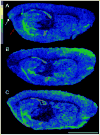Intracranial electrode implantation produces regional neuroinflammation and memory deficits in rats
- PMID: 20026042
- PMCID: PMC2824074
- DOI: 10.1016/j.expneurol.2009.12.006
Intracranial electrode implantation produces regional neuroinflammation and memory deficits in rats
Abstract
Deep brain stimulation (DBS) is an established treatment for advanced Parkinson's disease (PD). The procedure entails intracranial implantation of an electrode in a specific brain structure followed by chronic stimulation. Although the beneficial effects of DBS on motor symptoms in PD are well known, it is often accompanied by cognitive impairments, the origin of which is not fully understood. To explore the possible contribution of the surgical procedure itself, we studied the effect of electrode implantation in the subthalamic nucleus (STN) on regional neuroinflammation and memory function in rats implanted bilaterally with stainless steel electrodes. Age-matched sham and intact rats were used as controls. Brains were removed 1 or 8 weeks post-implantation and processed for in vitro autoradiography with [(3)H]PK11195, an established marker of microglial activation. Memory function was assessed by the novel object recognition test (ORT) before surgery and 2 and 8 weeks after surgery. Electrode implantation produced region-dependent changes in ligand binding density in the implanted brains at 1 as well as 8 weeks post-implantation. Cortical regions showed more intense and widespread neuroinflammation than striatal or thalamic structures. Furthermore, implanted animals showed deficits in ORT performance 2 and 8 weeks post-implantation. Thus, electrode implantation resulted in a widespread and persistent neuroinflammation and sustained memory impairment. These results suggest that the insertion and continued presence of electrodes in the brain, even without stimulation, may lead to inflammation-mediated cognitive deficits in susceptible individuals, as observed in patients treated with DBS.
Published by Elsevier Inc.
Figures







Similar articles
-
Single electrode and multiple electrode guided electrical stimulation of the subthalamic nucleus in advanced Parkinson's disease.Neurosurgery. 2007 Nov;61(5 Suppl 2):346-55; discussion 355-7. doi: 10.1227/01.neu.0000303993.82149.98. Neurosurgery. 2007. PMID: 18091250 Clinical Trial.
-
Deep brain stimulation mitigates memory deficits in a rodent model of traumatic brain injury.Brain Stimul. 2024 Nov-Dec;17(6):1186-1196. doi: 10.1016/j.brs.2024.10.006. Epub 2024 Oct 15. Brain Stimul. 2024. PMID: 39419474
-
Relationship between neuropsychological outcome and DBS surgical trajectory and electrode location.J Neurol Sci. 2009 Dec 15;287(1-2):159-71. doi: 10.1016/j.jns.2009.08.003. Epub 2009 Sep 19. J Neurol Sci. 2009. PMID: 19767016 Free PMC article.
-
Cognition and Depression Following Deep Brain Stimulation of the Subthalamic Nucleus and Globus Pallidus Pars Internus in Parkinson's Disease: A Meta-Analysis.Neuropsychol Rev. 2015 Dec;25(4):439-54. doi: 10.1007/s11065-015-9302-0. Epub 2015 Oct 12. Neuropsychol Rev. 2015. PMID: 26459361 Review.
-
The incidence of seizures following Deep Brain Stimulating electrode implantation for movement disorders, pain and psychiatric conditions.Br J Neurosurg. 2009 Apr;23(2):179-83. doi: 10.1080/02688690802673197. Br J Neurosurg. 2009. PMID: 19306174 Review.
Cited by
-
Implantable NMR Microcoils in Rats: A New Tool for Exploring Tumor Metabolism at Sub-Microliter Scale?Metabolites. 2021 Mar 17;11(3):176. doi: 10.3390/metabo11030176. Metabolites. 2021. PMID: 33803055 Free PMC article.
-
Cognitive dysfunction with aging and the role of inflammation.Ther Adv Chronic Dis. 2011 May;2(3):175-95. doi: 10.1177/2040622311399145. Ther Adv Chronic Dis. 2011. PMID: 23251749 Free PMC article.
-
Parallel declines in cognition, motivation, and locomotion in aging mice: association with immune gene upregulation in the medial prefrontal cortex.Exp Gerontol. 2011 Aug;46(8):643-59. doi: 10.1016/j.exger.2011.03.003. Epub 2011 Mar 29. Exp Gerontol. 2011. PMID: 21453768 Free PMC article.
-
Reliability of VEP Recordings Using Chronically Implanted Screw Electrodes in Mice.Transl Vis Sci Technol. 2015 Apr 28;4(2):15. doi: 10.1167/tvst.4.2.15. eCollection 2015 Apr. Transl Vis Sci Technol. 2015. PMID: 25938003 Free PMC article.
-
Immediate Epileptogenesis after Kainate-Induced Status Epilepticus in C57BL/6J Mice: Evidence from Long Term Continuous Video-EEG Telemetry.PLoS One. 2015 Jul 10;10(7):e0131705. doi: 10.1371/journal.pone.0131705. eCollection 2015. PLoS One. 2015. PMID: 26161754 Free PMC article.
References
-
- Alegret M, Junque C, Valldeoriola F, Vendrell P, Pilleri M, Rumia J, Tolosa E. Effects of bilateral subthalamic stimulation on cognitive function in Parkinson disease. Arch Neurol. 2001;58:1223–1227. - PubMed
-
- Ardouin C, Pillon B, Peiffer E, Bejjani P, Limousin P, Damier P, Arnulf I, Benabid AL, Agid Y, Pollak P. Bilateral subthalamic or pallidal stimulation for Parkinson’s disease affects neither memory nor executive functions: a consecutive series of 62 patients. Ann Neurol. 1999;46:217–223. - PubMed
-
- Benabid AL, Chabardes S, Mitrofanis J, Pollak P. Deep brain stimulation of the subthalamic nucleus for the treatment of Parkinson’s disease. Lancet Neurol. 2009;8:67–81. - PubMed
-
- Benabid AL, Chabardes S, Seigneuret E. Deep-brain stimulation in Parkinson’s disease: long-term efficacy and safety - What happened this year? Curr Opin Neurol. 2005;18:623–630. - PubMed
Publication types
MeSH terms
Substances
Grants and funding
LinkOut - more resources
Full Text Sources
Medical

